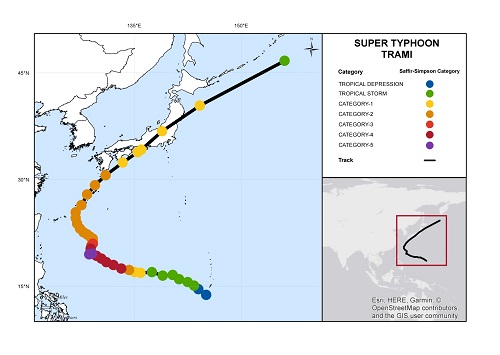
In the West-Pacific Basin, Typhoon Trami made landfall in the city of Tanabe, Japan (Wakayama prefecture) on 30 September 2018, at around 11 UTC (8 PM local time), according to media reports. Before reaching Honshu, the typhoon had rendered considerable impacts while making close approach to Okinawa, Kyūshū and Shikoku Islands. Trami brought significant flood impacts as a result of heavy rainfall and storm surge, as well as variable property damage due to wind. Significant power outages and transportation disruption have been reported by media. Over 4.3 million people were given evacuation orders or advisories. Media reports indicate at least four fatalities and 120 injured. It will take time to fully assess the complete scope and severity of the event, and our first thoughts and concerns are with those directly affected.
Meteorological Discussion
Typhoon Trami originated at around 18 UTC on 20 September as a tropical depression south of Guam. The system strengthened as it headed north and west across the warm waters of the Philippine Sea. According to the Joint Typhoon Warning Center (JTWC), the feature was upgraded to a tropical storm on 21 September at 06 UTC, with 1-minute sustained winds of around 65 km/h (40 mph). The storm continued to follow a general west-northwesterly motion while gaining strength. Trami was classified as a typhoon by the JTWC on 22 September at 18 UTC, with 1-minute sustained winds of around 120 km/h (75 mph). The system continued a general west-northwest to northwesterly motion over the next day or so, while undergoing a period of rapid intensification. Trami was classified as a super typhoon on 24 September at 06 UTC, with 1-minute sustained winds of around 240 km/h (150 mph). Trami then reached its peak intensity at 00 UTC on 25 September, with 1-minute sustained winds of around 260 km/h (160 mph), a Category-5 on the Saffir-Simpson Scale.

Hazard data illustrated in the natural catastrophe worldwide. These reports cover catastrophes including worldwide tropical cyclones, earthquakes, major UK and European floods and any other natural event that is likely to incur a significant loss to the (re)insurance industry. Please email CAT.i@guycarp.com if you wish to be added to the free email distribution list.